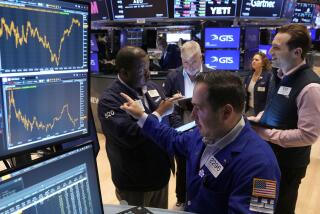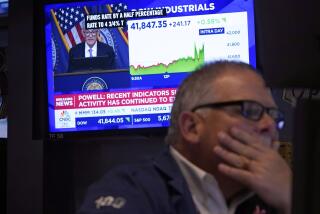Interest Rates Drop as Fed Opens Coffers
WASHINGTON — The Federal Reserve, continuing to work in concert with central banks in Europe and Japan, poured still more funds into the U.S. banking system Wednesday in its effort to reassure investors that it is determined to sustain economic activity despite Monday’s stock market plunge.
Interest rates fell for the third day in a row as inflationary expectations evaporated in the wake of the sell-off in stocks. Investors took heart from the Fed’s dramatic easing of monetary policy.
“The Fed has made it clear that the market needn’t fear higher interest rates right now,” said James Capra, a leading bond analyst for Shearson Lehman Bros. in New York. “They are not going to allow any weakness to develop.”
The action by the Fed, together with less aggressive moves by other central banks, helped propel a broad-based advance in worldwide stock markets.
Traders said that the Fed injected new cash into the nation’s financial system in late morning in a further effort to drive down interest rates and reassure markets.
On Tuesday, the Fed took similar steps after Federal Reserve Chairman Alan S. Greenspan announced that the central bank was ready to “serve as a source of liquidity to support the economic and financial system.”
Those moves were echoed in West Germany, where the Bundesbank hastily retreated from interest rate increases it had engineered earlier this month and promised to supply funds at 3.8%. And, in Tokyo, the Bank of Japan vowed to provide additional liquidity to prevent the stock market’s battering from spreading to the nation’s financial institutions.
Wednesday’s action by the Fed drove down the federal funds rate, the key rate that banks charge for short-term loans to one another, as low as 5.87% from the 6.75% rate of late Tuesday. The rate closed at 6.5% for the day, a full percentage point below the 7.5% level on Monday.
“That’s the clearest sign of what the Fed is trying to do,” said Lee Ohanian, a senior economist at Security Pacific National Bank in Los Angeles. But Ohanian warned that it is too early to determine whether the plunge in short-term market rates will translate into less expensive lending expenses for business and consumers.
“A lot more smoke has to clear before we get an indication of where interest rates may be going,” he said. “You could see higher rates again once it is clear that the economy is going to survive this blow relatively intact.”
Other economists, however, are convinced that lower interest rates are likely to remain in force for quite some time. “It’s going to be a long time before people start worrying about inflation and higher interest rates again,” Capra said. “Everybody has been shaken to their bones by the experience on Monday.”
The move to ease interest rates to combat any danger of recession marks an abrupt about-face for the Fed. A week ago, Greenspan, who took over as Fed chairman from Paul A. Volcker in August, had been under intense market pressure to raise interest rates to quell concerns of a falling dollar and rising inflation.
Despite the reversal in Fed policy, the dollar remained relatively strong in foreign currency markets, suggesting that foreign investors are not withdrawing any of their massive investments from U.S. markets.
The dollar finished modestly higher against most major currencies in uneventful New York trading Wednesday, after rising in the Far East but trading mostly lower in Europe.
The dollar rose to 1.8165 West German marks in New York, compared to 1.8125 a day earlier, and gained another notch against the Japanese yen to 144.60 from 144.30.
“The dollar just kept being very well supported,” said James Vick, a currency trader for Manufacturers Hanover Trust Co. in New York. “People are heartened by the fact that the U.S. financial markets aren’t falling apart.”
The decline in interest rates was across the board. Yields on three-month Treasury bills fell to about 5.64% in late afternoon trading, down from 5.8% on Tuesday. Last week, by comparison, rates were as high as 7.2%.
In the long-term market, which is less subject to direct Fed influence, rates fell at a more modest pace. The 30-year government bond dropped to 9.45% from 9.5% on Tuesday and 10.2% at the end of last week.
The Federal Reserve holds sway over short-term interest rates when it buys and sells government securities. If it sells government securities, the Fed soaks up reserves in the banking system, a move that generally pushes up short-term interest rates.
But when it buys such securities from banks, which it did in large quantities Wednesday, the Fed pumps additional money into the system. With more money in their reserves, banks can make loans at lower rates.
More to Read
Inside the business of entertainment
The Wide Shot brings you news, analysis and insights on everything from streaming wars to production — and what it all means for the future.
You may occasionally receive promotional content from the Los Angeles Times.










